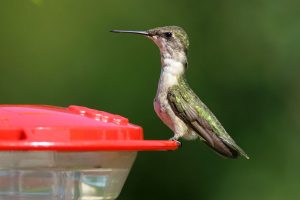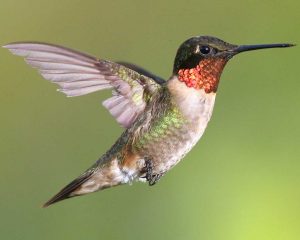
I leaned over the footbridge railing and looked where she was pointing. At first all I could see was a tangle of zig-zagging sycamore branches, but then a movement caught my eye. A tiny wing flick revealed a tiny bird: a female Ruby-throated Hummingbird, squeezed atop a tiny lichen-covered knob that could only be her nest. We collectively held our breath, amazed and awed by such a small bird.
Ruby-throats are the only regular hummingbird over vast stretches of eastern North America, including Ohio. They are a northern outlier of a huge family of tropical flower-feeding hoverers that includes over 330 species, mostly in the flower-rich forest-edges of Central and South America. Over a dozen species have adapted to the seasonally-changing flower regimens of deserts and mountains of the southwestern US, but that’s as close as hummingbird diversity gets to us. Only the rugged little Rufous Hummingbird of the western mountains penetrates further north.

Why aren’t hummers more common in our flower-rich spring and summer seasons? Hummingbirds are ‘metabolic monsters’ whose metabolism is the fastest of any endothermic animal. They beat their wings at over 50 times per second and can have a heart rate exceeding 1000 beats per minute, all to power a hovering flight that is more like an insect than a bird. Their tiny size allows them to survive on flower nectar, but just accentuates their heat loss and helps to drive this extreme metabolism. In the tropics, they have co-evolved with a host of flowers, developing strategies to forage adeptly enough to consume their weight in nectar every day. At night, they dial down their torrid metabolism as much as ten-fold, entering a torpor to save energy.
Ruby-throats carry all this baggage north when they head up to Ohio every spring. Firstly, they make a staggering 400- 500 mile direct flight over parts of the Gulf of Mexico just to reach North America, a flight that no other hummer makes. They need to double their weight prior to this flight, packing on the grams for the non-stop ordeal, probably adding a healthy dose of soft insects and spiders to their diet to do so. Once they arrive, they are keen to search out flowers and feeders; they are fiercely territorial around reliable nectar sources. The Midwest has few hummingbird-specific flowers, so the birds focus on tubular flowers and compete with bees, moths, and butterflies, revisiting productive flower patches over a series of days until the nectar wanes.
Breeding just adds to their stress. Males become hyper-territorial and will display to females and rivals with an 8-foot dive display. Nest-building and young-rearing are female tasks: she weaves the tiny elastic cup from spider silk, lichens, and bud scales, lays 1-2 eggs, and rears the nestlings alone. The cozy little nest helps by conforming to the nestlings and insulating them while they develop control of their metabolisms; still, the mother bird must feed them every 15-30 minutes and brood them during rain and night. After 18-21 days of this, the young fledge; the presumably exhausted females rarely try to get off a second brood.
So how does this affect when and where we see them in central Ohio? In April and May, look for them around large flower patches, especially if there are red or purple tubular flowers present. During nesting, the females don’t stray too far from their nests, but the males will wander all over. By late July, when most nesting is over, look for both sexes around large patches of flowers or feeders, as they try to recover from the ordeal of nesting and territory defense. Large public gardens, like Whetstone and Inniswood, are excellent places to look for them. Or you can just put up a feeder – then, they’ll find you, and you can prepare to be amazed.


